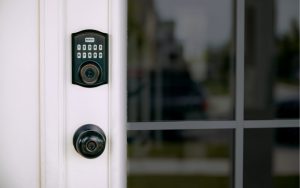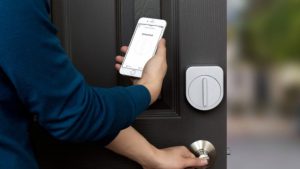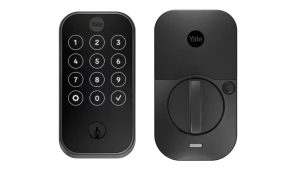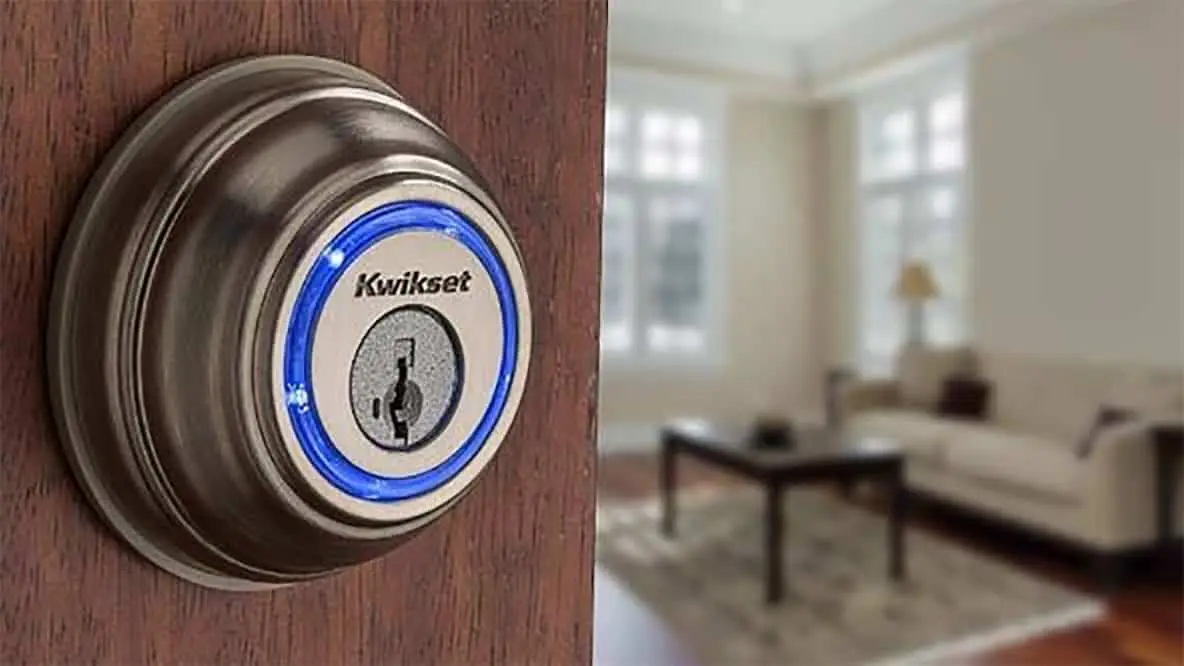In previous years locking system was weaker and people needed to be more careful for protection their properties. By the passage of the time Smart locks come. People know them as keyless locks or electronic locks. They have achieved popularity in current years due to their comfort and state-of-the-art characteristics. But there is a big question that are smart locks safe?
These locks supply a choice to conventional automatic locks by letting users to handle entrance to their houses or inferences utilizing a smartphone, keypad, or other wireless gadgets.
While smart locks propose several advantages, such as straightforward structure, faraway entry permission, and integration with smart home methods, the query of their security and protection is of critical significance. We are here to explain more about the safety of these intelligent and modern locks and answer the question are smart locks safe?
Table of Contents
ToggleWhen did smart locks come?

Are smart locks safe? When it comes to assessing the security of intelligent locks, it is crucial to regard both their benefits and possible vulnerabilities. Smart locks generally use encryption protocols and authentication tools to guard entrance permission to the lock’s control strategy.
This encryption guarantees that the communication between the lock and the accepted devices is protected, miscalculating the hazard of unauthorized entrance. Moreover, many smart lock factories enforce safety elements such as:
- two-factor authentication
- tamper detection
- activity logs
- improve the overall protection of the lock
Further, some smart locks have physical key backups, allowing users to unlock the lock manually in case of power outages or lock malfunctions. Nevertheless, despite these safety standards, there are yet possible dangers associated with smart locks.
To answer the question that are smart locks safe? We have to say, like any internet-connected instrument, smart locks can be weak to cyber attacks if not properly secured.
Hackers may attempt to use openness in the lock’s software or achieve unauthorized entrance to the associated portable app or intelligent house strategy.
In some circumstances, investigators have recognized safety defects in certain smart lock norms, emphasizing the significance of selecting reputed trademarks and regularly updating the lock’s firmware.
Another concern is the potential of technical glitches or malfunctions. Smart locks depend on electricity and wireless connectivity, which means that power outages or network disorders can influence their functionality.
It’s important to have backup strategies in place, such as manual key entrance or alternative energy references, to provide you can always join your property in case of such happenings.
To mitigate the risks associated with smart locks and ensure their safety, it is advisable to follow best practices.
What are smart locks?
These contain utilizing strong, memorable passwords for lock-related accounts, regularly correcting the lock’s firmware and associated apps, and maintaining your smartphone or other official devices safe.
Also, it is recommended to select smart locks from reputed factories with a path record of prioritizing safety and supplying frequent updates and patches. While smart locks deliver comfort and cutting-edge elements, it is important to approach their protection with carefulness.
By comprehending the possible hazards, enforcing proper safety standards, and constructing informed options, you can enjoy the advantages of smart locks while underestimating the possibilities of unauthorized entrance or cyber openness.
Unlike traditional locks, smart locks use wireless communication protocols such as Bluetooth, Wi-Fi, or Zigbee to interact with accepted users and appliances.
This permits distant function and monitoring of the lock’s situation, equipping homeowners with more incredible comfort and flexibility in controlling entrance to their belongings.
Smart locks usually come with companion mobile apps or web interfaces that help users to close or open entrances, make quick or regular pass codes, and obtain information about entrance activity in real-time.
One of the essential elements of smart locks is their capability to combine seamlessly with additional smart home appliances and procedures. This interoperability permits users to design customized automation routines and improve overall house safety.
For example, you can synchronize smart locks with safety cameras, movement detectors, and warning methods to initiate detailed movements in reaction to noticed circumstances, such as automatically shutting the entrance when the safety technique is ready or transmitting warnings when unauthorized access endeavors are possible to detect.
Additionally, you can integrate smart locks with virtual associates like Amazon Alexa, Google Assistant, or Apple HomeKit, helping voice management and further improving the user experience.
Smart lock definition

In terms of installation and compatibility, manufacturers design smart locks to retrofit existing entrance hardware, constructing them fairly straightforward to establish for most homeowners.
They normally come in different methods and finishes to complete additional architectural types and choices. Nevertheless, it’s significant to mention that not all smart locks are equal in terms of safety characteristics and trustworthiness.
Hence, it’s fundamental to analysis and selects a reputed smart lock manufacturer that prioritizes robust encryption, safe authentication instruments, and standard firmware updates to mitigate possible susceptibility and guarantee the security of your house.
All around, the most useful elements of smart locks integrate cutting-edge technology with useful functionality to offer users an everyday and safe solution for managing entrance to their houses and possessions.
Whether it’s the faraway entrance, keyless entrance, customizable entrance codes, smart home integration, or activity logging, smart locks authorize users with more excellent management and peace of mind over their house safety.
A smart lock is a technical improvement in house safety that replaces classic lock and key mechanisms with electronic entrance management techniques.
What are the risks of smart locks?
After getting know the answer of are smart locks safe, it is good to know the risks of smart locks. While smart locks present comfort and improved safety characteristics, they even come with specific dangers that users should be conscious about
- Cyber security Susceptibilities: Smart locks lean on wireless communication protocols and internet connectivity, constructing them easy to hacking tries. Cybercriminals may use susceptibilities in the smart lock’s firmware or mate apps to achieve unauthorized entrance to the lock, potentially compromising the safety of the belongings.
- Physical Safety Considerations: Although smart locks show electronic locking tools, they are always weak to physical tampering. Evil people may try to avoid the smart lock utilizing conventional lock-picking strategies or brute force techniques, mainly if the lock’s physical structure is invalid or inefficient.
- Trustworthiness and Specialized Problems: Smart locks are electronic appliances that are prone to technological malfunctions and software glitches. A malfunctioning smart lock may result in unanticipated lockouts, inability to access the belongings, or other functional problems. In some circumstances, software updates or firmware promotions may inadvertently submit bugs or compatibility problems, affecting the trustworthiness of the smart lock technique.
- Battery Dependence: Most smart locks are battery-operated, leaning on batteries to force the electronic parts and wireless communication modules. In the possibility of battery loss or shortage, the smart lock may become useless, potentially leaving the belongings weak to unauthorized entrance. Standard battery maintenance and monitoring are necessary to mitigate this threat.
- Privacy Considerations: Smart locks gather and share data about user entrance marks, lock situation, and further connected details to guide apps or cloud servers. There may be privacy implications associated with the collection and storage of this data, particularly if it is not adequately protected against unauthorized entrance or misusage. Users should examine the privacy procedures of smart lock factories and accept reasonable steps to protect their individual data.
How is the authentication process of smart locks?
The authentication method of smart locks is a crucial element of their safety architecture, providing that qualified people can gain entrance to a belonging.
Are smart locks safe? To answer this question you have to know that smart locks generally use different authentication techniques to confirm the identity of users before granting access.
Biometric Authentication

Some developed smart locks contain biometric authentication technologies such as fingerprint recognition or facial recognition. Biometric authentication delivers a heightened class of security by uniquely recognizing people based on their physiological features.
Users must review their fingerprint or face utilizing the smart lock’s biometric detector to establish them before the lock will open.
Passcode/PIN Authentication
Many smart locks support passcode or individual identification number (PIN) authentication, where users input a predetermined code through a keypad or touchscreen interface.
The passcode/PIN functions as a digital key to open the entrance, and users can customize and control numerous codes for additional people, such as household associates, visitors, or assistance providers. This procedure delivers comfort and flexibility while supporting safety.
Mobile Device Authentication
With the addition of smartphones, mobile appliance authentication has become increasingly widespread among smart lock users. You can pair Smart locks with users’ smartphones via Bluetooth or Wi-Fi, letting for seamless authentication established on immediacy or via a reliable mobile app.
Users can open the entrance utilizing their smartphone as a digital key, stopping the demand for physical keys or passcodes.
Key Fob Authentication
Some smart locks support key fob authentication, where users hold a tiny electronic gadget, comparable to a keychain remote that expresses wirelessly with the lock.
When in close proximity to the lock, the key fob transmits a signal to authenticate the user and open the entrance. This procedure delivers comfort for users who prefer not to lean on smartphones or classic keys.
General, the authentication method of smart locks plays a critical role in providing the safety and integrity of access control methods.
By enforcing potent authentication procedures and encryption protocols, smart lock manufacturers aim to deliver users with peace of mind knowing that their houses and possessions are safe against unauthorized access.
What are the best features of smart locks?

The answer of are smart locks safe connect to the features of smart locks. Smart locks submit a range of elements that improve comfort, safety, and flexibility for users. Some of the most useful characteristics of smart locks include the following:
- Remote Key and Management: One of the standout characteristics of smart locks is the proficiency to manage and monitor them remotely utilizing a smartphone or further internet-connected widgets. Whether you’re at work, on vacation, or entirely away from the house, you can close or open your door, grant entry to guests, and receive real-time notifications about entrance activity from anywhere with an internet association.
- Keyless Entrance: Smart locks eliminate the demand for classic keys by suggesting keyless entrance opportunities such as passcodes, biometric authentication, or smartphone-based digital keys. This not only stops the annoyance of holding physical keys but also improves safety by decreasing the hazard of lost or stolen keys slipping into inaccurate hands.
- Customizable Entrance Codes: Smart locks permit users to construct and handle numerous entrance codes for additional people, such as household fellows, visitors, or assistance providers. Users can customize the truth time and approvals associated with per entrance code, supplying more significant control over who can enter their belongings and when.
- Integration with Smart Home Ecosystems: Many smart locks are consistent with widespread smart home platforms and ecosystems, qualifying for seamless integration with other smart widgets and techniques such as safety cameras, movement detectors, and virtual helpers. This integration allows users to make personalized automation practices and improve general house safety and comfort.
- Activity Logging and Attention: Smart locks usually feature activity logging qualifications that record and timestamp entrance activity, including lock/open possibilities and failed entrance tries. Users can check this activity log to follow who has entered or left their possessions and when. Further, smart locks can transmit instant alertness to users’ smartphones in case of questionable activity or unauthorized entrance tries, supplying counted peace of mind.
Conclusion
In conclusion, while smart locks suggest comfort and state-of-the-art qualities, their security eventually depends on different aspects such as encryption power, firmware updates, and user routines. We have explained about the answer of are smart locks safe in this article.
As with any technology, smart locks can be safe when correctly enforced and supported, but users should stay awake and accept the required safeguards to mitigate possible threats.
When choosing a smart lock, prioritizing safety qualities is important. Look for locks with strong encryption protocols, such as AES 128-bit or more elevated, to protect contact between the lock and the connected appliances.
Besides, opt for locks that undergo frequent safety audits and firmware updates to manage susceptibility promptly and improve general safety. Assume smart locks with multi-factor authentication qualifications, such as PIN codes, biometric distinction, or closeness detectors.
These added layers of verification can seriously maintain safety by assuring that only qualified people can access your house or belongings. Consider the integration possibilities of the smart lock with other smart home widgets and platforms.
Compatibility with reputed home automation techniques and strict entrance management can improve general safety and simplify administration via centralized platforms.
Consider the physical durability and tamper resistance of the smart lock. Look for locks assembled from high-quality materials and provided with anti-tamper characteristics, such as strengthened deadbolts and anti-drill plates, to prevent unauthorized entrance tries.
Likewise, examine the importance and trustworthiness of the smart lock manufacturer. Select trademarks with a path description of making safe and responsible outcomes, supported by favorable examinations and buyer help assistance. Funding from a reputed brand can ensure long-term safety and trustworthiness for your smart lock technique.

